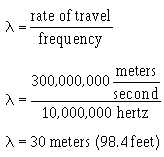1-10
Q-13. How do you calculate the wavelength of a sine wave?
HETERODYNING
Information waveforms are produced by many different sources and are generally quite low in
frequency. A good example is the human voice. The frequencies involved in normal speech vary from one
individual to another and cover a wide range. This range can be anywhere from a low of about 90 hertz
for a deep bass to as high as 10 kilohertz for a high soprano.
The most important speech frequencies almost entirely fall below 3 kilohertz. Higher frequencies
merely help to achieve more perfect sound production. The range of frequencies used to transmit voice
intelligence over radio circuits depends on the degree of FIDELITY (the ability to faithfully reproduce the
input in the output) that is desired. The minimum frequency range that can be used for the transmission of
speech is 500 to 2,000 hertz. The average range used on radiotelephone circuits is 250 to 2,750 hertz.
Frequencies contained within the human voice can be transmitted over telephone lines without
difficulty, but transmitting them via radio circuits is not practical. This is because of their extremely long
wavelengths and the fact that antennas would have to be constructed with long physical dimensions to
transmit or radiate these wavelengths. Generally, antennas have radiating elements that are 1/4, 1/2, 1, or
more full wavelengths of the frequency to be radiated. The wavelengths of voice frequencies employed on
radiotelephone circuits range from 1,200,000 meters at 250 hertz to 109,090 meters at 2,750 hertz. Even a
quarter-wave antenna would require a large area, be expensive to construct, and consume enormous
amounts of power.
As studied in NEETS, Module 10, Introduction to Wave Propagation, Transmission Lines, and
Antennas, radio frequencies do not have the limitations just described for voice frequencies. Radio waves,
given a suitable antenna, can often radiate millions of miles into space. Several methods of modulation
can be used to impress voices frequencies onto radio waves for transmission through space.
In the modulation process, waves from the information source are impressed onto a radio-frequency
sine wave called a CARRIER. This carrier is sufficiently high in frequency to have a wavelength short
enough to be radiated from an antenna of practical dimensions. For example, a carrier frequency of 10
megahertz has a wavelength of 30 meters, as shown below:
Construction of an antenna related to that wavelength does not cause any problems.
An information wave is normally referred to as a MODULATING WAVE. When a modulating wave
is impressed on a carrier, the voltages of the modulating wave and the carrier are combined in such a
manner as to produce a COMPLEX WAVE (a wave composed of two or more parts). This complex wave

